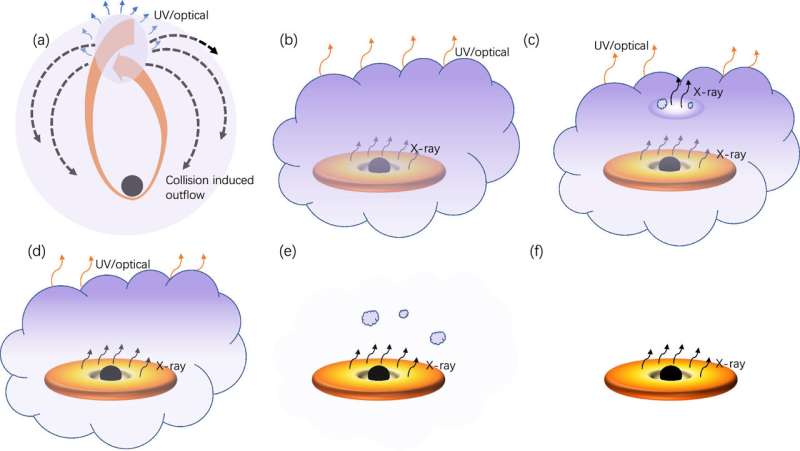This article has been reviewed according to Science X's editorial process and policies. Editors have highlighted the following attributes while ensuring the content's credibility:
fact-checked
peer-reviewed publication
trusted source
proofread
Researchers unveil unique tidal disruption event with pronounced early optical bump

A research team from the University of Science and Technology of China (USTC) of the Chinese Academy of Sciences (CAS) presented a detailed analysis of a tidal disruption event (TDE) with unique characteristics, providing new insights into the behavior of TDEs and their multiwavelength emissions. The study was published online in The Astrophysical Journal Letters.
When a star ventures too close to a supermassive black hole at the center of a galaxy, it gets torn apart by the black hole's immense tidal forces, resulting in a phenomenon known as a TDE.
The researchers found that the AT2023lli event observed by various ground and space telescopes including the newly constructed Wide Field Survey Telescope (WFST) jointly operated by the USTC and the Purple Mountain Observatory of CAS exhibited unique features unlike previous TDEs. Traditionally, TDE light curves display a smooth "rapid rise, slow decline" trend. However, AT2023lli deviated from this pattern significantly.
Optical monitoring revealed a strong "bump" in its early light curve, lasting nearly a month and separated by two months from the main peak. This extended and pronounced "bump" was unprecedented in TDE observations. The researchers proposed that the "bump" could be the result of the self-intersection of the stream debris, while the primary peak was likely generated by the reprocessed emission from the accretion process.
Moreover, the researchers observed delayed and intermittent X-ray emissions compared to optical/ultraviolet (UV) radiation, which they attributed to the obscuration of the accretion disk by outflowing material, resulting in the absorption and reprocessing of soft X-rays into optical/UV radiation. The intermittent nature of the X-ray emission was suggested to be due to the presence of an inhomogeneous reprocessing layer around the accretion disk, which could be associated with the obscuring material's patchy distribution.
This study underscores the importance of high-cadence, multiwavelength sampling in understanding the physics of TDEs. The sensitivity of WFST is highlighted in providing high-quality multicolor photometric data during the late evolution of AT2023lli.
The unique survey design of WFST's high-cadence deep fields, coupled with the recently launched Einstein Probe, holds promise for discoveries in transient source research including TDEs.
More information: Shifeng Huang et al, AT 2023lli: A Tidal Disruption Event with Prominent Optical Early Bump and Delayed Episodic X-Ray Emission, The Astrophysical Journal Letters (2024). DOI: 10.3847/2041-8213/ad319f
Journal information: Astrophysical Journal Letters
Provided by Chinese Academy of Sciences





















